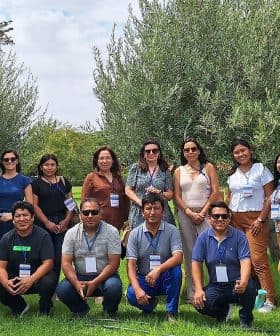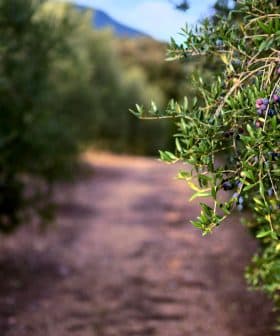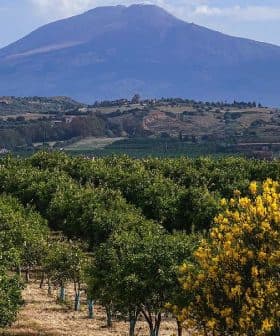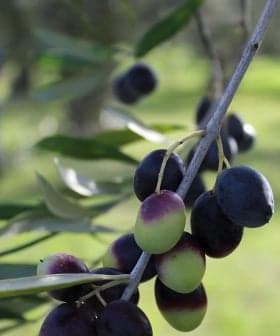Use of Fungus Found Effective Against Carriers of Xylella
The preliminary results of a field trial show that the Beauveria bassiana fungus reduced the number of meadow spittle bugs, which carry Xylella fastidiosa, by 80 percent.
 Field trial of fungus application
Field trial of fungus applicationPreliminary field trial results show that the Beauveria bassiana fungus is effective against the meadow spittlebug, a carrier of Xylella fastidiosa pauca, and researcher Claudio Cantini believes this could be a sustainable solution to combat the spread of the disease associated with olive quick decline syndrome. Cantini’s ongoing experiments involve applying the fungus-based product to spittlebug larvae in olive groves to decrease insect populations and potentially open up new possibilities for using fungi against Xylella carriers.
Preliminary results of a field trial demonstrated that the Beauveria bassiana fungus appeared to be beneficial against the meadow spittlebug, a known carrier of Xylella fastidiosa pauca.
Claudio Cantini, a researcher at the Italian National Research Council’s Institute of BioEconomy, said the tests were a good first step in finding a sustainable solution to curb the spread of the disease, which is associated with olive quick decline syndrome (OQDS).
We believe that this experimentation could open new scenarios to the use of fungi against the carriers of Xylella and therefore the spread of the bacterium.
“The experimentation was carried out in the frame of the LIFE Resilience project, which aims to find sustainable solutions to curb the spread of Xylella fastidiosa in intensive olive and almond groves,” Cantini said. “Then, we are implementing the information obtained by the large E.U.-funded research projects on Xylella, in order to find and communicate to farmers sustainable agronomic practices, from actions that increase soil vitality to plant treatments, with the aim of enhancing the resilience of trees to pests.”
As part of the three-year project, Cantini started to monitor the presence of the meadow spittlebug in various olive groves in Follonica, Tuscany, where he noticed a high presence of this insect in some areas, with significant differences in population density between adjacent zones.
See Also:Xylella fastidiosa News“I started to do little preliminary tests with products allowed in organic farming, based on the information gathered in Puglia,” Cantini explained. “I knew that a product based on the fungus Beauveria bassiana, which attacks various types of insects, works well in a humid environment, and then I applied it, along with other products, on the foam produced by spittlebugs.
After a week, the researchers noticed that the fungus-based product had a greater effect than a pyrethroid insecticide used as a positive control, as in some cases the foam disappeared, in other cases, the number of insects decreased.
“The reduction compared to the control was 80 percent,” Cantini noted. “The fungus germinated, produced hyphae, passed through the insect’s cuticle, penetrated and parasitized it, causing it to die.”
The product should be applied when spittlebug larvae are present, therefore, depending on the area, between the end of April and mid-May. Considering that the spittlebug larvae produce the foam as protection, a common mistake fighting them is to apply substances such as sulfur.
“In those cases, since the spittlebug feels something unpleasant within its shelter, it moves away to produce another foam nest, and the foam production increases further,” Cantini said. “The discovery of the action of fungi on insects dates back to the 1800s, but we still do not know all the effects on all the insects, and we believe that this experimentation could open new scenarios to the use of fungi against the carriers of Xylella and therefore the spread of the bacterium.”
“We feel a sense of urgency to communicate this preliminary information,” he added. “I suppose there will be some criticism over the fact that we released preliminary data that still need to be confirmed, but I did not want to wait to release data that could be useful.”
Cantini said that he is drafting a short communication with the support of an entomologist, “so that next year, anyone in the scientific community can investigate, verify, and test this or other fungal strains and products of different companies, remaining independent.”
The researcher believes that the disclosure of these results has a social utility, as it paves the way for further verifications by research institutions and companies.
“In my opinion, it is important to disseminate this type of solutions, especially in light of what is suggested by the European Food Security Agency, namely that it will be difficult to completely get rid of Xylella, and therefore it is necessary to carefully monitor the plants and the population of insects to curb the problem.”
Experiments with Beauveria bassiana will continue in another traditional olive grove, similar to those in Puglia, and in super-intensive cultivation of Arbequina.
“We purchased a hyperspectral camera, and we are planning to begin monitoring with drones as soon as we have finalized the data collection procedure,” Cantini said.









